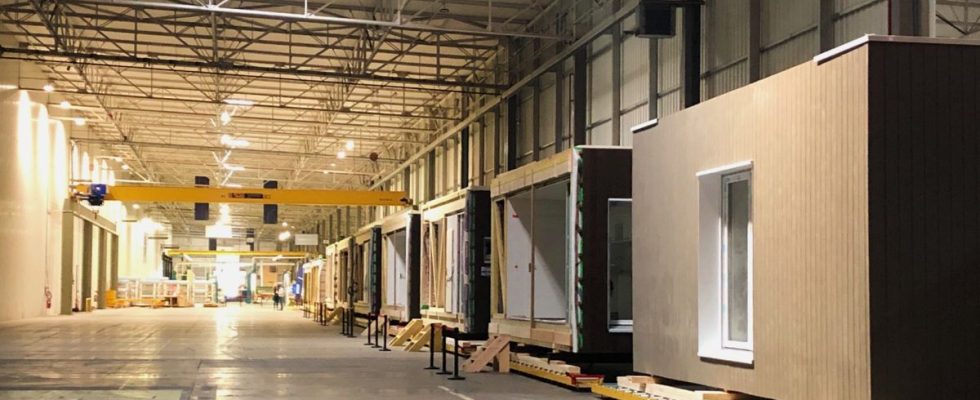It is a huge hangar that has long welcomed Citroën’s little hands. A time when the French automobile industry was at its peak and running at full speed to provide a car to all the inhabitants of this country. Passed under the PSA then Stellantis flag, this large hall has long housed a workshop designing prototypes of the two French brands. From now on, it is no longer cars but housing that the factory in Chartres-de-Bretagne (Ille-et-Vilaine) sees passing by every day. A factory to make houses? Yes ! And apartments too. An “chain” production attempted by the real estate developer Réalités as a response to the housing crisis. As prices skyrocket, land becomes scarce and the cost of materials soars, offsite housing production has many arguments. Some even dare to say that the construction sector is playing its survival there.
“We are almost certain that there will be no more workers on the construction sites in about ten years. So how do we move forward? “. Bertrand Favre is the new manager of Mayers, the new name of Réalités Build Tech, the low-carbon sector of the property builder. At the age of 40, the young boss dreams of being one of the leaders in “off-site” construction in France. His company, which already employs 70 people, specializes in the design of modular housing built on an assembly line in its factory in Rennes. Like a puzzle, the pieces are then assembled on site to become residential houses or even multi-storey buildings. This will be the case of the future Constellation residence and its 522 accommodations, which will be fitted out for the Rennes School of Business in order to accommodate the many foreign students of the business school.
A production time “20 to 30% faster”
First advantage? The rapidity. “We can reduce the manufacturing time by 20 to 30%. In the factory, we can consolidate, organize. We are dry, sheltered from bad weather, we don’t have to worry about drying times, for example,” explains Quentin Goudet, director of Mayers. In his Janais hangar, his companions are already able to take out three 18 m³ modules per day. “In traditional construction, it would take us weeks. And we can dream more! We must immerse ourselves in the model of the automotive industry, ”says the leader. In Angers, the future childhood center managed by Arpeje should be shaped by Réalités.
Faced with the shortage of labor in the construction sector, the “off-site” solution also offers advantageous working conditions, far from the “mud and noise” of construction sites, he underlines. “We have invested a lot in handling equipment to avoid carrying heavy loads”. As at neighboring Stellantis, Mayers workers work under gantries and with rails that move the walls and partitions forward. “We can train our employees internally, offer them a more peaceful working environment”. Yoann Choin-Joubert, founder of the Réalités group, does not hide his desire to use robotics and artificial intelligence to design his modular housing. “It will be the only solution to the labor shortage,” he says.

The massification of production should above all make it possible to lower the cost of construction in a context of soaring prices of materials. With its factory, the Mayers company hopes to produce housing at “less than 2,000 euros per square meter”. Easy for a house but more complicated when you have to stack them for collective housing. The company will first have to find enough customers to intensify its production and increase productivity. A major challenge for a sector accustomed to incessant stops absolutely incompatible with assembly line work. “A factory must work in constant flows. We will have to adapt. The promoters too, for that matter, because they will have to learn to pay differently. They will no longer be able to wait for delivery,” warns Yoann Choin-Joubert.
Already well established for individual houses (especially tiny houses), the concept of modular housing is particularly scrutinized by local authorities. Despite a housing policy hailed by all, the Rennes metropolitan area is seeing its list of people waiting for social housing grow. Just over 26,000 people are currently waiting, whereas there were only 16,000 in 2016. The reasons are many but can be summed up as follows: less numerous, real estate programs are now taking longer to emerge from the ground and more expensive, excluding de facto the most modest. “People no longer have the capacity to find accommodation, it is worrying. Our role as a community is to provide quick fixes. Modular housing can enable us to respond to this by occupying abandoned land,” explains Nathalie Demeslay, housing director at Rennes Métropole.
To implement this “transitional urbanism”, the community claims to need “movable” housing through a solution called “without fixed land”. A concept that allows you to find accommodation quickly and well, while waiting for the more traditional construction scheme to come into effect: calls for tenders, public inquiries, architectural competitions, etc. This mobile accommodation solution also offers the advantage of responding to the housing crisis in the most touristic areas. In these sectors, housing has become inaccessible, preventing the recruitment of seasonal workers. The modular can also respond to this.

